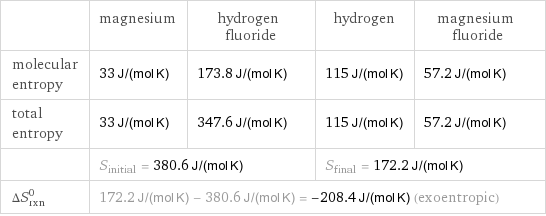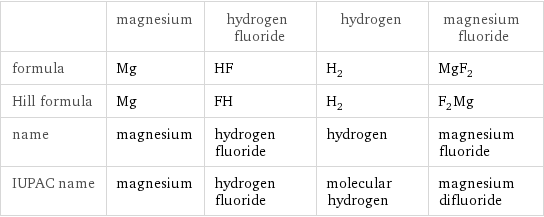Input interpretation

Mg magnesium + HF hydrogen fluoride ⟶ H_2 hydrogen + MgF_2 magnesium fluoride
Balanced equation

Balance the chemical equation algebraically: Mg + HF ⟶ H_2 + MgF_2 Add stoichiometric coefficients, c_i, to the reactants and products: c_1 Mg + c_2 HF ⟶ c_3 H_2 + c_4 MgF_2 Set the number of atoms in the reactants equal to the number of atoms in the products for Mg, F and H: Mg: | c_1 = c_4 F: | c_2 = 2 c_4 H: | c_2 = 2 c_3 Since the coefficients are relative quantities and underdetermined, choose a coefficient to set arbitrarily. To keep the coefficients small, the arbitrary value is ordinarily one. For instance, set c_1 = 1 and solve the system of equations for the remaining coefficients: c_1 = 1 c_2 = 2 c_3 = 1 c_4 = 1 Substitute the coefficients into the chemical reaction to obtain the balanced equation: Answer: | | Mg + 2 HF ⟶ H_2 + MgF_2
Structures

+ ⟶ +
Names

magnesium + hydrogen fluoride ⟶ hydrogen + magnesium fluoride
Reaction thermodynamics
Enthalpy

| magnesium | hydrogen fluoride | hydrogen | magnesium fluoride molecular enthalpy | 0 kJ/mol | -273.3 kJ/mol | 0 kJ/mol | -1124 kJ/mol total enthalpy | 0 kJ/mol | -546.6 kJ/mol | 0 kJ/mol | -1124 kJ/mol | H_initial = -546.6 kJ/mol | | H_final = -1124 kJ/mol | ΔH_rxn^0 | -1124 kJ/mol - -546.6 kJ/mol = -577.6 kJ/mol (exothermic) | | |
Entropy

| magnesium | hydrogen fluoride | hydrogen | magnesium fluoride molecular entropy | 33 J/(mol K) | 173.8 J/(mol K) | 115 J/(mol K) | 57.2 J/(mol K) total entropy | 33 J/(mol K) | 347.6 J/(mol K) | 115 J/(mol K) | 57.2 J/(mol K) | S_initial = 380.6 J/(mol K) | | S_final = 172.2 J/(mol K) | ΔS_rxn^0 | 172.2 J/(mol K) - 380.6 J/(mol K) = -208.4 J/(mol K) (exoentropic) | | |
Equilibrium constant
![Construct the equilibrium constant, K, expression for: Mg + HF ⟶ H_2 + MgF_2 Plan: • Balance the chemical equation. • Determine the stoichiometric numbers. • Assemble the activity expression for each chemical species. • Use the activity expressions to build the equilibrium constant expression. Write the balanced chemical equation: Mg + 2 HF ⟶ H_2 + MgF_2 Assign stoichiometric numbers, ν_i, using the stoichiometric coefficients, c_i, from the balanced chemical equation in the following manner: ν_i = -c_i for reactants and ν_i = c_i for products: chemical species | c_i | ν_i Mg | 1 | -1 HF | 2 | -2 H_2 | 1 | 1 MgF_2 | 1 | 1 Assemble the activity expressions accounting for the state of matter and ν_i: chemical species | c_i | ν_i | activity expression Mg | 1 | -1 | ([Mg])^(-1) HF | 2 | -2 | ([HF])^(-2) H_2 | 1 | 1 | [H2] MgF_2 | 1 | 1 | [MgF2] The equilibrium constant symbol in the concentration basis is: K_c Mulitply the activity expressions to arrive at the K_c expression: Answer: | | K_c = ([Mg])^(-1) ([HF])^(-2) [H2] [MgF2] = ([H2] [MgF2])/([Mg] ([HF])^2)](../image_source/d772ce859b79b9f379592e8e97195083.png)
Construct the equilibrium constant, K, expression for: Mg + HF ⟶ H_2 + MgF_2 Plan: • Balance the chemical equation. • Determine the stoichiometric numbers. • Assemble the activity expression for each chemical species. • Use the activity expressions to build the equilibrium constant expression. Write the balanced chemical equation: Mg + 2 HF ⟶ H_2 + MgF_2 Assign stoichiometric numbers, ν_i, using the stoichiometric coefficients, c_i, from the balanced chemical equation in the following manner: ν_i = -c_i for reactants and ν_i = c_i for products: chemical species | c_i | ν_i Mg | 1 | -1 HF | 2 | -2 H_2 | 1 | 1 MgF_2 | 1 | 1 Assemble the activity expressions accounting for the state of matter and ν_i: chemical species | c_i | ν_i | activity expression Mg | 1 | -1 | ([Mg])^(-1) HF | 2 | -2 | ([HF])^(-2) H_2 | 1 | 1 | [H2] MgF_2 | 1 | 1 | [MgF2] The equilibrium constant symbol in the concentration basis is: K_c Mulitply the activity expressions to arrive at the K_c expression: Answer: | | K_c = ([Mg])^(-1) ([HF])^(-2) [H2] [MgF2] = ([H2] [MgF2])/([Mg] ([HF])^2)
Rate of reaction
![Construct the rate of reaction expression for: Mg + HF ⟶ H_2 + MgF_2 Plan: • Balance the chemical equation. • Determine the stoichiometric numbers. • Assemble the rate term for each chemical species. • Write the rate of reaction expression. Write the balanced chemical equation: Mg + 2 HF ⟶ H_2 + MgF_2 Assign stoichiometric numbers, ν_i, using the stoichiometric coefficients, c_i, from the balanced chemical equation in the following manner: ν_i = -c_i for reactants and ν_i = c_i for products: chemical species | c_i | ν_i Mg | 1 | -1 HF | 2 | -2 H_2 | 1 | 1 MgF_2 | 1 | 1 The rate term for each chemical species, B_i, is 1/ν_i(Δ[B_i])/(Δt) where [B_i] is the amount concentration and t is time: chemical species | c_i | ν_i | rate term Mg | 1 | -1 | -(Δ[Mg])/(Δt) HF | 2 | -2 | -1/2 (Δ[HF])/(Δt) H_2 | 1 | 1 | (Δ[H2])/(Δt) MgF_2 | 1 | 1 | (Δ[MgF2])/(Δt) (for infinitesimal rate of change, replace Δ with d) Set the rate terms equal to each other to arrive at the rate expression: Answer: | | rate = -(Δ[Mg])/(Δt) = -1/2 (Δ[HF])/(Δt) = (Δ[H2])/(Δt) = (Δ[MgF2])/(Δt) (assuming constant volume and no accumulation of intermediates or side products)](../image_source/4fdc8037d52866829d7dd6dcd04bb9e4.png)
Construct the rate of reaction expression for: Mg + HF ⟶ H_2 + MgF_2 Plan: • Balance the chemical equation. • Determine the stoichiometric numbers. • Assemble the rate term for each chemical species. • Write the rate of reaction expression. Write the balanced chemical equation: Mg + 2 HF ⟶ H_2 + MgF_2 Assign stoichiometric numbers, ν_i, using the stoichiometric coefficients, c_i, from the balanced chemical equation in the following manner: ν_i = -c_i for reactants and ν_i = c_i for products: chemical species | c_i | ν_i Mg | 1 | -1 HF | 2 | -2 H_2 | 1 | 1 MgF_2 | 1 | 1 The rate term for each chemical species, B_i, is 1/ν_i(Δ[B_i])/(Δt) where [B_i] is the amount concentration and t is time: chemical species | c_i | ν_i | rate term Mg | 1 | -1 | -(Δ[Mg])/(Δt) HF | 2 | -2 | -1/2 (Δ[HF])/(Δt) H_2 | 1 | 1 | (Δ[H2])/(Δt) MgF_2 | 1 | 1 | (Δ[MgF2])/(Δt) (for infinitesimal rate of change, replace Δ with d) Set the rate terms equal to each other to arrive at the rate expression: Answer: | | rate = -(Δ[Mg])/(Δt) = -1/2 (Δ[HF])/(Δt) = (Δ[H2])/(Δt) = (Δ[MgF2])/(Δt) (assuming constant volume and no accumulation of intermediates or side products)
Chemical names and formulas

| magnesium | hydrogen fluoride | hydrogen | magnesium fluoride formula | Mg | HF | H_2 | MgF_2 Hill formula | Mg | FH | H_2 | F_2Mg name | magnesium | hydrogen fluoride | hydrogen | magnesium fluoride IUPAC name | magnesium | hydrogen fluoride | molecular hydrogen | magnesium difluoride
Substance properties

| magnesium | hydrogen fluoride | hydrogen | magnesium fluoride molar mass | 24.305 g/mol | 20.006 g/mol | 2.016 g/mol | 62.302 g/mol phase | solid (at STP) | gas (at STP) | gas (at STP) | solid (at STP) melting point | 648 °C | -83.36 °C | -259.2 °C | 1266 °C boiling point | 1090 °C | 19.5 °C | -252.8 °C | 2260 °C density | 1.738 g/cm^3 | 8.18×10^-4 g/cm^3 (at 25 °C) | 8.99×10^-5 g/cm^3 (at 0 °C) | 3.15 g/cm^3 solubility in water | reacts | miscible | | slightly soluble dynamic viscosity | | 1.2571×10^-5 Pa s (at 20 °C) | 8.9×10^-6 Pa s (at 25 °C) | odor | | | odorless |
Units
